Choosing the quietest blow dryer you can find is about more than just convenience. Having it in such close proximity to your ears could lead to damage with long-term exposure.
So, in this article, I’ll review my top picks for the best quiet hair dryers on the market. After, I’ll go over what I consider to be the most important factors in making a decision. By the end, you should have found a hair dryer that can tame your locks without deafening you!
Our Top 9 Picks
Below are my selections for the top 10 best quiet hair dryers on the market. Where possible, I’ve included a dB, although it’s not especially common for manufacturers to list these. Instead, we’ll look at real-world reviews of the product’s noise rating.
1. Top Pick: Chignon Smart Leafless Hair Dryer
- Power: 1400 W
- Heat Settings: 3
- Speed Settings: 3
- Min Noise @3ft: 67-68dB
- Max Noise @3ft: 75.5dB
- Max Noise:
- Ionizing: Yes
- Weight: 1.34 lb
This hair dryer is basically a copy of the Dyson blow dryer, except it’s about half the price.
It does shine through its build quality and its bladeless design. The housing feels sturdy in hand and doesn’t look as plasticky as the Xpoliman below.
At max speed, I’ve recorded 73dB @3ft. from the sound level meter. This is very low noise emission considering it delivers the best airflow from all the hair dryers I tested.
At low-speed, the Chignon provides around twice more airflow for lower noise emissions (67-68dB) compared to a cheaper alternative like the Jinri or the Xpoliman hair dryers. At least you have this option if you need to reduce your dB count.


It has 3 speed settings, up to a maximum airflow of 26m/s, which is blazing fast. There are also 3 temperature settings, and it uses negative ion technology to reduce frizz and improve shine, making it ideal for all hair types. With the 2 styling nozzles, you’ve got plenty of flexibility.
In the below video, you can check my noise test along with airflow and temperature measurement.
One great feature of this hair dryer, which is missing from most others, is a removable filter. It’s much easier to clean and means you don’t have to deal with that horrible burning dust smell when you use it.
Its major downside is the location of the air intake. It’s on the handle, and some users have reported that it sucks their hair in. Unfortunately, there’s not much to be done about this, so just be careful if you have long hair.
- Uses bladeless technology to reduce noise.
- Removable dust filter.
- High air speed.
- Air intake isn’t in a great location.
- Far from the 66dB advertised by the manufacturer.
2. Top Budget Pick: Xpoliman 2000W Hair Dryer
- Power: 2000 W
- Heat Settings: 3
- Speed Settings: 2
- Min Noise @3ft: 69.5dB
- Max Noise @3ft: 75dB
- Ionizing: Yes
- Weight: 1.3 lb
The Xpoliman hair dryer is right around the cutoff for a budget-friendly hair dryer. If you go much lower in price, the quality and product lifespan start to make it not worth it. As such, I recommend sticking around $45-$50 for a quiet blow dryer.
Luckily, this model offers fast drying without too much noise. It has 3 heat and 2 speed settings, along with a cool shot button. The attachments include a diffuser and concentrator, so it’s suitable for all hair types.
Its 2000W motor is one of the most powerful on this list, meaning it’ll dry even thick hair quite quickly.
I measured its max noise rating at 75dB (from 3 ft away), which is not quiet. But this is surprisingly low noise for the wind speed it delivers (18 m/s).
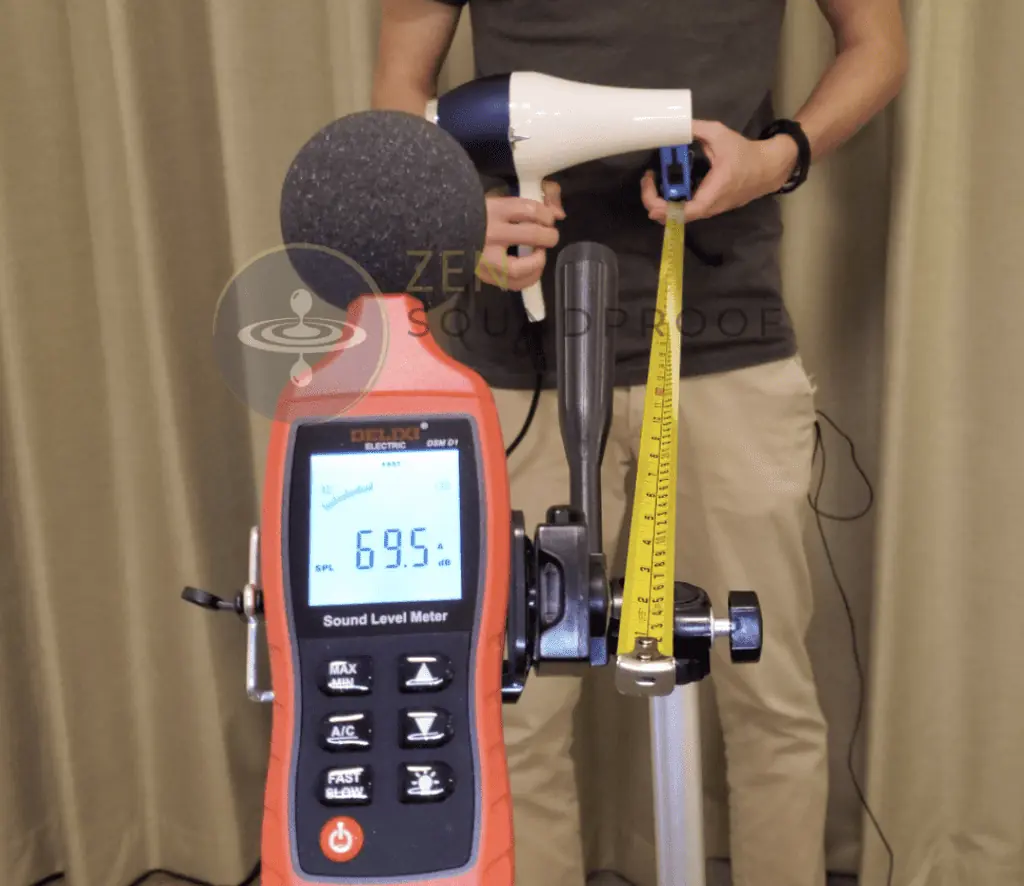
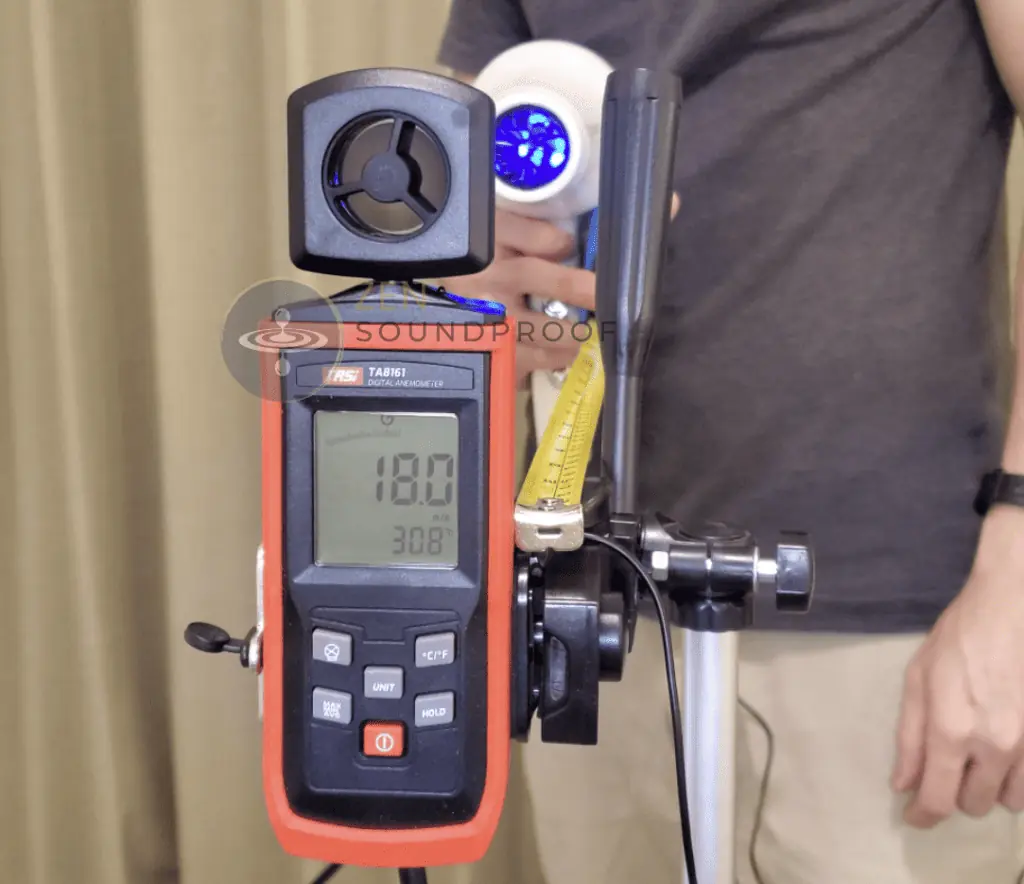
Some users state that the cord isn’t very long. But at 6ft., it’s not especially short either. If you think this might be an issue, simply look for a model with a longer cord because there are plenty.
- Quiet operation.
- Suitable for all hair types.
- Negative ion tech for sheen.
- Power cord might be a bit short.
3. Top Pick for Travel: Siyoo Ionic Blow Dryer
- Power: 1600 W
- Heat Settings: 3
- Speed Settings: Dial
- Min Noise @3ft: 69dB
- Max Noise @3ft: 74dB
- Ionizing: Yes
- Weight: 0.82 lb
The Siyoo takes a lot of inspiration from the Dyson hair dryer. It has the color tones and similar external appearance, but it doesn’t feature a bladeless architecture. Importantly, it comes at a more entry-level price. At 0.82lbs., it’s pretty lightweight and it’s ergonomic and powerful. This makes it a good pick for use at home and while traveling.
There are 3 temperature settings, and you control the fan speed with a dial rather than a switch. I found it to be so much more convenient than switches.
On my decibel meter, I recorded 74dB at max speed (3 ft. away). This is a good result considering that most of the hair dryers I tested are above 75dB at max speed.
Moreover, with the dial knob, it’s easy to tune your ideal fan speed and lower noise emission. The minimum I’ve recorded sat around 69dB. This is what you’d expect for a standard hair dryer.
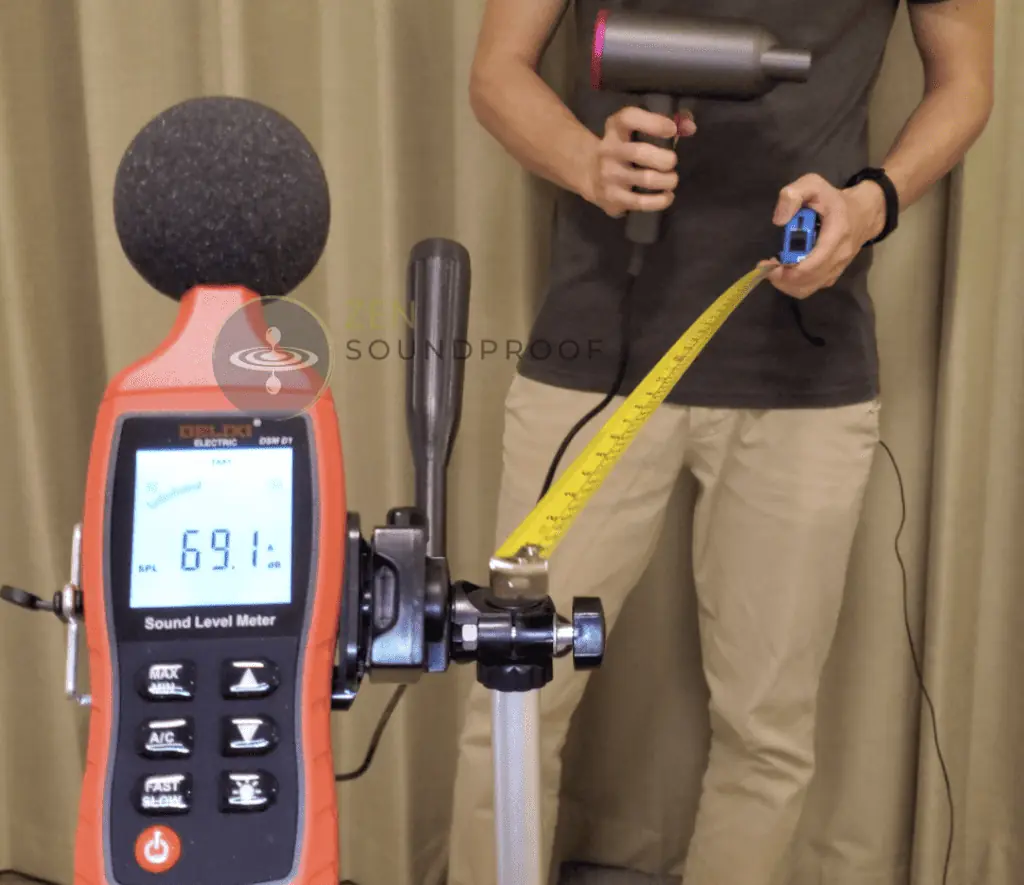

Better yet, the attachments are magnetic, so they don’t fall off easily. It comes with a diffuser and concentrator for different hair types. Like the Chignon, it has a removable air filter to avoid that horrible burnt dust smell.
Some users state that it doesn’t have the same kind of hair treatment functionality as higher-end models. But this only seems to be an issue on thinner hair types. Plus, if you’re only using it for travel, it shouldn’t be too much of an issue.
- Uses a dial for speed settings.
- Removable air filter.
- Magnetic attachments.
- Doesn’t leave thin hair types very shiny.
4. Gamma+ XCell Professional Hair Dryer
- Power: 1400 W
- Heat Settings: 4
- Speed Settings: 3
- Min Noise: 66dB
- Max Noise: NC
- Ionizing: Yes
- Weight: 0.65 lb
The Gamma+ almost won my top pick because of its low noise level. At only 66dB at minimum speed, it’s pretty quiet for the amount of airflow it provides.
In my experience, the max noise level should sit around 75dB, like most hair dryers of this size and power wattage.
It lost the spot of top pick because of its price, as it’s around $100 more expensive than my top pick for best quiet hair dryer.
It’s a lightweight model that the manufacturer claims is half the size and weight of a normal hair dryer, making it much easier to handle, particularly if you’re using it for long periods.
The motor is a digital, low-energy model that has amazing blowing power. Combined with the 4 nozzle attachments for different hair types, and you’ve got a pretty great hair dryer. It also has negative ion technology, which helps reduce frizz and static.
Overall, it’s quite a functional piece of equipment. There are 3 speed settings. Each speed can run at any of the 4 heat settings (no heat, low, medium, high). In total, it gives you 12 heat/speed settings options. The buttons lock to ensure nothing changes during use.
As mentioned, the main downside is the price. It’s very expensive. But, if you want one of the quietest hair dryers with plenty of functionality, this is unfortunately the price you pay.
- The lightest on this list.
- Low noise level of 66dB.
- Energy-efficient.
- Suitable for different hair types.
- Very pricey.
5. Jinri 1875W Ionic Hair Dryer
- Power: 1875 W
- Heat Settings: 3
- Speed Settings: 2
- Min Noise @3ft: 68.3dB
- Max Noise @3ft: 76dB
- Ionizing: Yes
- Weight: 1.26 lb
The Jinri uses a ceramic heater that emits some infrared heat. In turn, the infrared prevents frizz, which is backed by feedback from users. It’s what’s used in salons, so it’s an easy way to get a professional quality finish without breaking the bank.
It has 2 speed settings and 3 heat settings, and a cool shot button for styling. It uses ionic technology to reduce static and increase sheen. Combined with the diffuser and concentrator attachments, you’ve got plenty of flexibility.
In terms of noise level, I found from my test that:
- It’s very good at the lowest speed setting, as I’ve recorded around 68dB @ 3ft. away from the decibel meter. Most blow dryers hardly go below 69dB, even at low speeds.
- At max speed, it’s average, with a recording of 76dB. I found the noise to be very standard compared to other hair dryers of this size and power.
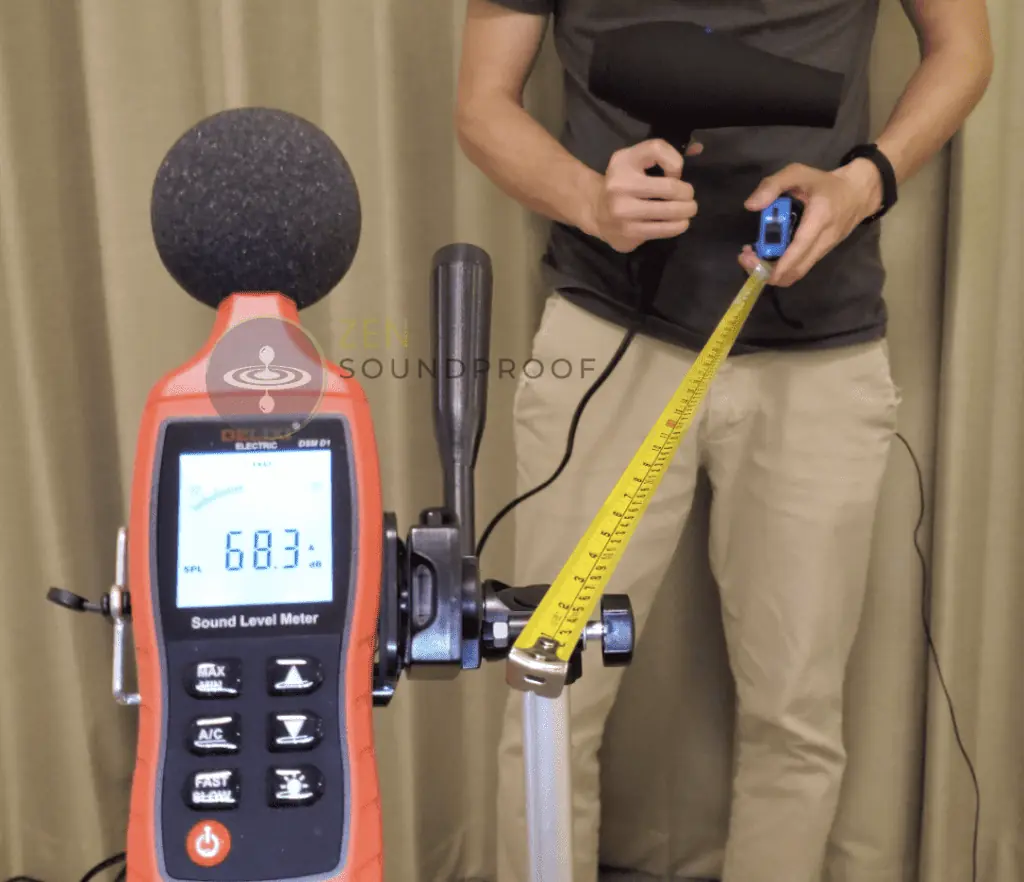
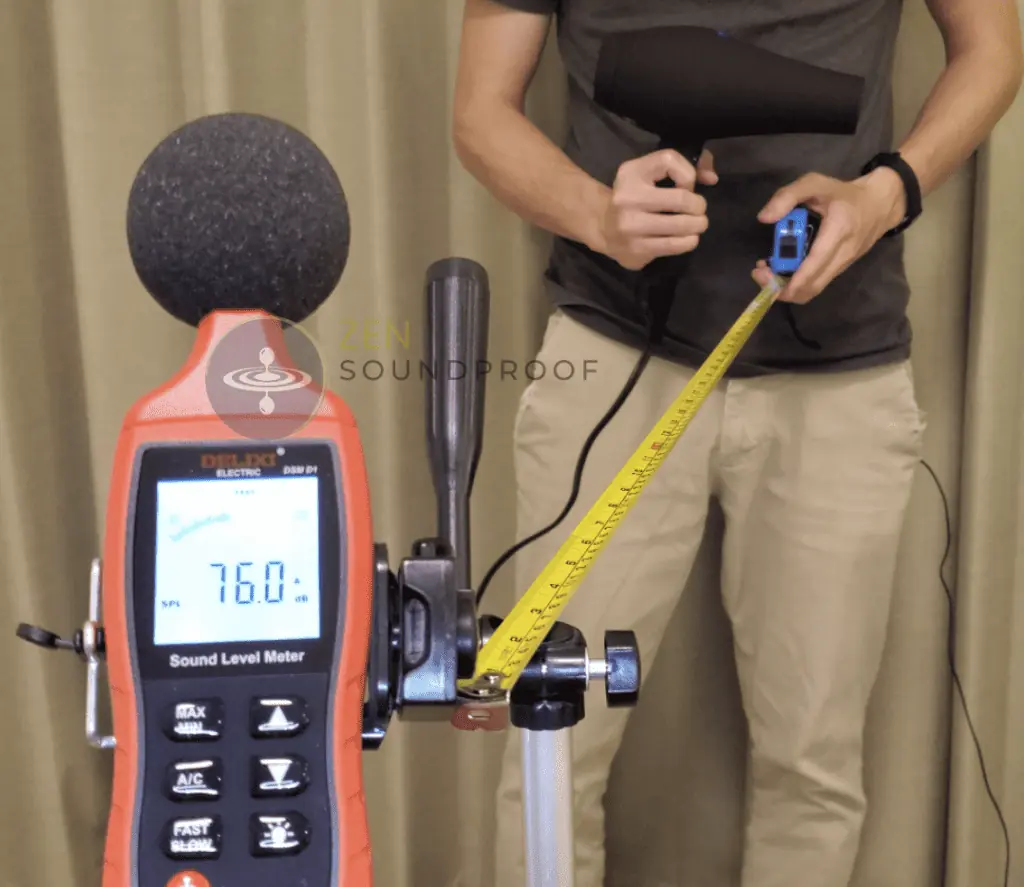
At 1875W, it’s more powerful than the Chignon above. It doesn’t make a substantial difference to drying time, but considering this hair dryer is around quarter of the price, it’s an attractive option nonetheless.
The main issue with this hair dryer is that the attachments don’t stay on too well. Providing you’re careful, though, this shouldn’t be an issue.
- Lightweight and ergonomic.
- Ceramic heater dries hair quickly.
- Fairly quiet for its motor power.
- Attachments fall off quite easily.
6. Rusk 2000W Blow Dryer
- Power: 2000 W
- Heat Settings: 3
- Speed Settings: 3
- Min Noise: 69 dB
- Max Noise: NC
- Ionizing: Yes
- Weight: 1.0 lb
The Rusk blow dryer has a 2000W motor, which is quite powerful for a hair dryer. Even so, plenty of users state that it’s quieter than their previous hair dryers. Unsurprisingly, we have no noise rating to back this up. That said, one user tested it and rated it at 69dB.
At only 1lb., it’s incredibly light. This makes it a good option for a travel dryer, although it’s not as small as my travel pick above. Plus, it’s considerably more expensive, so you’d probably want this as your everyday model.
It uses infrared heating and ionic technology to dry hair quickly and with a smooth finish. You get the standard heating and speed settings: 3 of each and a cool shot mode.
Some users state that the hottest settings are just too hot, and it’s easy to hit the buttons while using this. Unfortunately, there’s not much that can be done about this. If you think it’ll be an issue, go with a different model.
- 2nd lightest model on this list.
- Decent noise output at 69dB.
- Powerful motor and heating element.
- The hottest setting might be too high.
- It’s easy to hit buttons while in use.
7. Tymo 1200W Ionic Blow Dryer
- Power: 1200 W
- Heat Settings: 4
- Speed Settings: 3
- Min Noise: NC
- Max Noise: 80 dB
- Ionizing: Yes
- Weight: 0.66 lb
The Tymo has a noise rating of 80dB, which is technically quiet for a hair dryer. However, this is a bit louder than the quietest options on this list. 80dB is about the top end of the scale for a quiet hair dryer.
That said, users state how quiet it is, and it makes a higher-pitched noise than most dryers because it has a solid body. This means the only noise you’re getting is airflow rather than vibrational noise.
In terms of features, it’s a very functional product. You get 4 heat settings and 3 speed settings that show up on the LCD display. This gives you decent control over the settings but isn’t super necessary when they’re still controlled using buttons.
The only major downside is the price for what this dryer offers. While it’s functional and efficient, it’s fair to assume much of the price is to justify unnecessary features, such as the screen. But if you’re willing to pay good money for a hair dryer, this might be the one for you.
- Dries hair very quickly.
- Has magnetic nozzle attachments.
- Surprising power for a 1200W motor.
- Ultralight.
- Quite expensive.
8. Mint Professional Series Blow Dryer
- Power: 1875 W
- Heat Settings: 3
- Speed Settings: 2
- Min Noise: NC
- Max Noise: NC
- Ionizing: Yes
- Weight: 1.2 lb
This Mint hair dryer is another one that claims to be quiet but doesn’t offer a dB rating. Fortunately, several customers have stated that it’s quieter than expected for a dryer, so that’s something to go on.
It has 3 heat settings but only 2 speed settings. While this is technically enough, having more gives you greater flexibility over styling. But if you only plan to dry your hair, it should be fine.
The dryer uses infrared heat and ionic technology to keep hair smooth and shiny. It includes a diffuser and 2 nozzle attachments, so should be suitable for all hair types. Plus, with a 1875 wattage, it dries quickly.
Some users state it’s a bit bulky, especially when drying long or thick hair. The solution to this, if you think it’ll be an issue, is to simply look at other hair dryers, such as the Gamma +, Timo or Rusk above.
- Users state it’s fairly quiet.
- Features ionic technology.
- Buttons are well located – minimal risk of changing settings while in use.
- Quite bulky.
9. Panasonic Nanoe Oscillating Hair Dyer
- Power: 1875 W
- Heat Settings: 3
- Speed Settings: 2
- Min Noise: 72dB
- Max Noise: 79dB
- Ionizing: Yes
- Weight: 1.2 lb
The Panasonic hair dryer has hydrating functionality that’s slightly different to the standard negative ion technology. Regardless, it’s designed to still give you healthy hair, even for extended drying sessions.
Top Ten Reviews states that the Nanoe has an operating noise level of 72-79dB, which isn’t too bad for a quiet blow dryer. In fact, it states it’s the quietest one it tested (despite me finding quieter models).
One interesting feature is that the nozzle oscillates. It saves you from needing to move the hair dryer as much and means that the heat won’t be as concentrated when in use.
The oscillating nozzle is removable, and you can replace it with a diffuser and concentrated nozzle. In short, there are plenty of options depending on hair type and styling. Combine this with the 2 speed settings and three heat settings, and you’ll be able to do loads with your hair!
Some users state that the major downside is its weight. The oscillating feature makes it quite heavy, so it might be a challenge to hold it up for too long. However, other users state it’s one of the best quiet hair dryers they’ve owned.
- 72-79dB of noise output.
- Oscillating dryer.
- Hydrating function keeps hair smooth and healthy.
- Oscillating nozzle makes it quite heavy.
Noise Level of Hair Dryers
A regular hair dryer sits around 90dB when in operation. For comparison, this is roughly the same noise level as a truck passing you on the street or a lawn mower being used. 90dB is fairly loud, and prolonged exposure to anything over 85dB may cause damage after 2 hours.
A quiet hair dryer can reduce the decibel level to around 60dB, which is the equivalent of normal conversation. But because the decibel scale is logarithmic, dropping from 90dB to 60dB is actually the same as decreasing the sound energy by a factor of 100. It’s fair to consider anything below 80dB as quiet for a blow dryer.
I recommend checking out my article on noise pollution for more information on noise limits and their impacts.
How Does a Hair Dryer Work?
A hair dryer works by pushing hot air through a small space at high speeds. If you know anything about air pressure, it should be clear why they’re loud.
Let’s break down a hair dryer’s function in more detail to understand how it works.
- 1. You turn the hair dryer on, which starts the electric motor and heating element.
- 2. The motor powers a fan, which draws air in through the rear vent.
- 3. This air passes over a heating element, which can be coiled wires or ceramic.
- 4. The now heated air is pushed out the front nozzle, which is usually smaller than the rear vent to concentrate and direct the airflow.
- 5. When it reaches your hair, the hot air causes water to evaporate, thus drying it.
Sources of Noise in a Hair Dryer
Based on the steps above, we can narrow the sources of noise in a blow dryer down to:
- The fan. Fans create noise when pushing air. It’s more noticeable in a hair dryer because the fan is small and spins at a high RPM, which creates more noise. A solution is to buy a bladeless model, as these are much quieter.
- The motor. Motors aren’t the main source of noise, but they don’t help. The only thing you can do is opt for a brushless motor, as these are marginally quieter than universal motors (that are brushed models). More often than not, you won’t find this data in a hair dryer spec (especially for low-tier brands). But if it includes a brushless motor, you’re almost sure the manufacturer will brag about it in its product sheet.
- The nozzle. The more concentrated the airflow is when it exits the dryer, the higher its pressure will be. Your solution here is to remove the nozzle, but this means having wider airflow.
The bottom line is that there’s not loads you can do to an existing hair dryer, because you can’t easily swap the blades and motor. Instead, use this information to select a new model that’s quiet from the beginning. A bladeless hair dryer with a brushless motor is a good starting point.
Buying Guide
Functionality is particularly important for something like a hair dryer, as it must suit your hair type and styling needs. Below are the factors I consider to be most important when making a selection.
Noise
There’s not much else to say about noise level. Most manufacturers won’t list it, which makes finding an objectively quiet hair dryer quite difficult. If finding a quiet blow dryer is important, be prepared to do quite a bit of research.
Motor Type
Hair dryers come with either direct current (DC) or alternating current (AC) motors. Generally, AC motors are slightly louder than DC motors, but DC motors are more efficient. As such, most hair dryers have a DC motor.
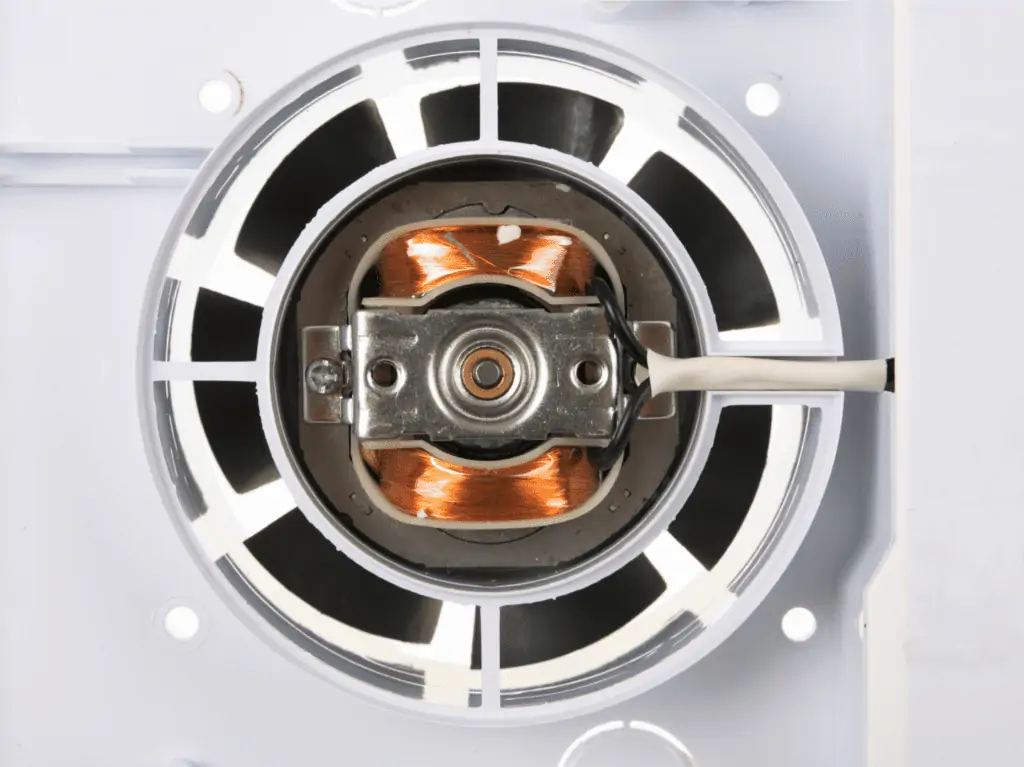
However, it doesn’t make a considerable difference when choosing the best quiet hair dryers. There are louder factors at play, so don’t make this your main buying factor.
What’s perhaps more important is whether the motor is brushed or brushless.
Brushless motors are quieter because they don’t create friction between the stator coils and the commutator (which is part of the rotor). The friction of the brushes ends up causing noise, wear, and increased power consumption compared to brushless. .
It’s worth mentioning because if you see a blow dryer labeled as brushed or brushless, you’ll at least know which one to pick.
Fan Type
With hair dryers, the standard design is a bladed fan inside the body. You can also get variations on a bladeless design, such as the technology used in most Dyson products.
Despite the name, they’re not actually bladeless. The fan blades are still inside the body but they push air into a hoop. It’s through this hoop that the air then blows onto your hair.
Bladeless models are quieter because there are fewer moving parts and housing between you and the fan blades. They’re the quietest hair dryers you’ll find on the market. But a bladed hair dryer can still be fairly quiet if it’s a high-quality model.
Power Level
We measure an electric device’s power in watts. Here’s a brief table to give you a better understanding of the power levels of hair dryers.
| Type of Blow Dryer | Wattage |
| Portable | 500-800 |
| Standard | 100-1500 |
| Salon Quality | 1500+ |
A hair dryer’s wattage refers to both its fan speed and heating element. Higher ratings mean the fan will spin at a higher RPM and that the element will heat quicker. You won’t necessarily get higher maximum temperatures, but it’ll get hotter faster.
From a convenience standpoint, a hair dryer with a higher wattage will dry your hair more quickly. But this does come at a cost, specifically to the noise level. Hair dryers with a higher wattage will be louder.
However, shorter drying time means less noise exposure, so it’s almost always better to go with a more powerful blow dryer.
If you have thin and/or straight hair, you can get away with lower wattage. But if your hair is thick and/or curly, go slightly higher with the wattage.
Technology
There are a few important technology factors in hair dryers that improve drying time and hair quality. These are:
Ionic Technology
Ionic technology is the process of charging the blown air with negative ions. It does so by passing through an array of negatively charged plates (using negative current) within the blow dryer. As a result, the air output becomes charged with negative ions.
Negative ions supposedly break down the hydrogen-hydrogen oxygen bonds within the water, which in turn helps it evaporate faster. In specific test conditions, ionized air has been proven to work for drying, but not at the scale of a blow dryer. This is simply because, with blow dryers, the drying time might not last long enough to see any significant change. It could also be because the density of ions in the charged air is too low.
Therefore, there’s no conclusive data, nor scientific tests, to show that ionic dryers dry hair faster. However, users’ feedback converges on the fact that it does appear to add sheen to hair.
Ceramic Heating
Another useful thing to look for is a ceramic heater. It follows the same principle as the ceramic heating element in a space heater. In short, when applying a current through ceramic materials, they heat up.
A ceramic heater can help control frizz because it distributes heat more evenly. Any small amount of water left on the hair generally causes the cuticle to swell by absorbing this remaining water, resulting in frizzy hair.
Also, ceramic heating elements are slightly more energy-efficient than traditional wire heaters, so can save you a bit of money if you use your blow dryer regularly.
Air Multiplier
This is a feature you’ll find on the highest-end models, specifically Dyson hair dryers. Rather than a traditional fan blowing directly at the use, the blow dryer produces a sheet of air that entrains surrounding air to go along via depression effect, thus increasing the airflow. The theory is that this provides cooler, more even airflow to dry hair as quick but with less damage. Check the video below to visualize the airflow movement in an air multiplier.
It’s not super important to have an air multiplier on your hair dryer. Ceramic and ionic technology will do the job fine, as will skipping heated drying hair once or twice a week.
Heat and Speed Settings
The speed and heat settings on a quiet blow dryer are perhaps the most important factors. After all, its sole job is to dry your hair.
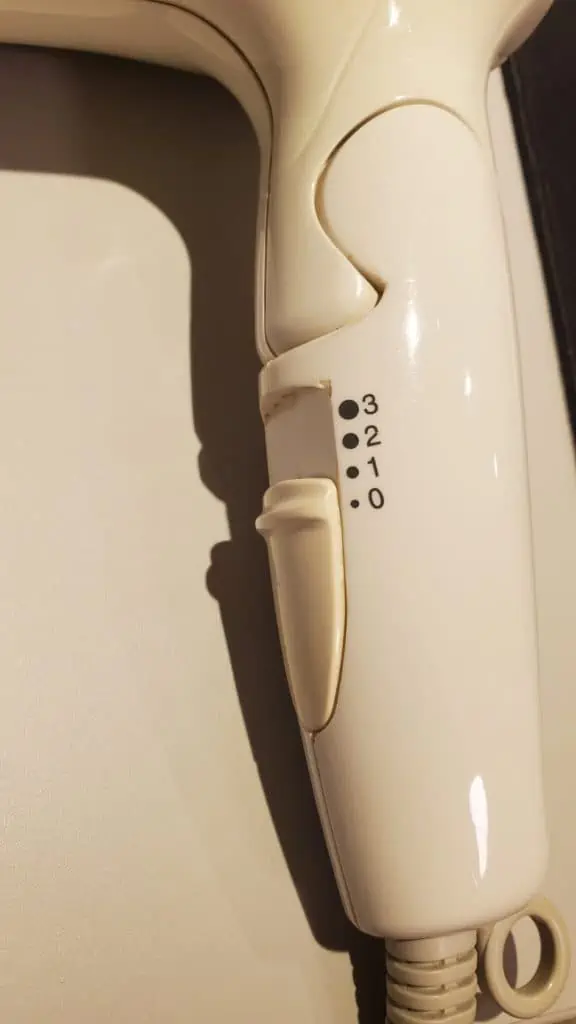
Hair is incredibly fragile, so having different heat settings is helpful. Plus, it gives you a greater range of styling options, as do multiple speed settings.
The most basic level of settings is often 2 speed settings and 3 heat settings, including a cold air blast. This’ll be enough for most people and hair types, as there’s enough variation between the heat settings.
Finally, an optional extra is the cool shot button. Unsurprisingly, this releases cool air rather than warm. You use this at the end of your drying cycle to set styles, particularly if you’ve used hair spray.
Weight
A hair dryer should be light enough for you to hold easily, particularly if you’ll be using it for a long time. Most manufacturers will state the size and weight of their product, so this should be an easy one to deal with.
A compact blow dryer can weigh as little as 0.56 lbs. (9oz.) but a full-size salon quality model can be 3lbs. or more.
Size matters if you plan to travel with your hair dryer. Compact designs are easier to pack into a bag but may sacrifice air power or some features. As such, you might not always find a low noise hair dryer that’s suitable for travel.
Nozzle
A hair dryer will typically come with a concentrator nozzle, which directs airflow into a smaller area and is better for styling straight hair. While this is helpful for drying your hair more quickly, it can make the hair dryer louder, too.
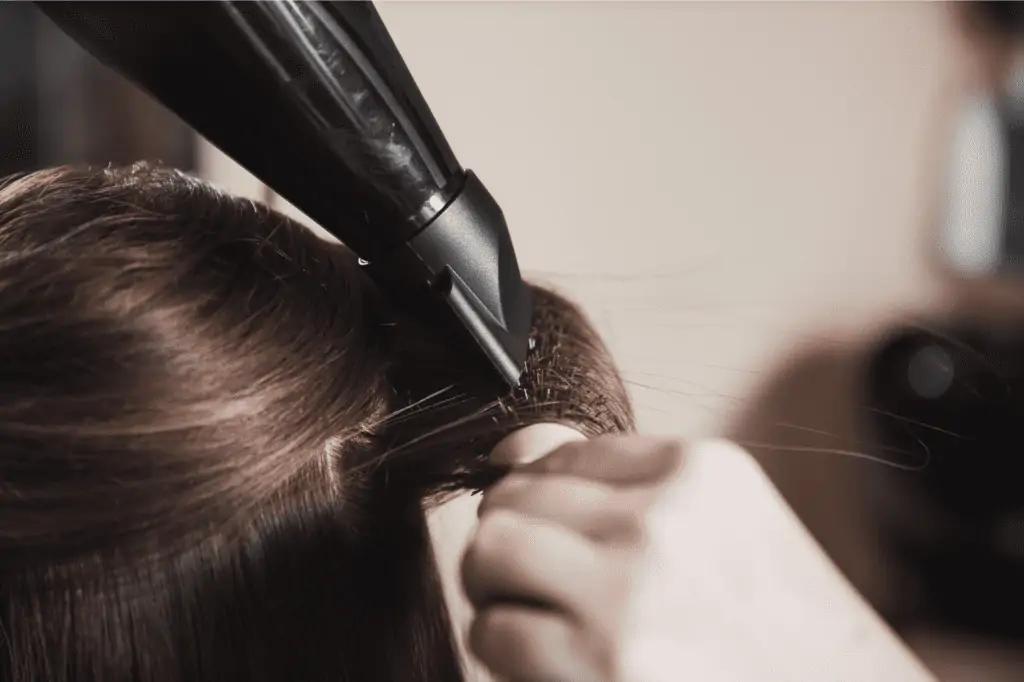
But you should also consider looking for a diffuser, which is better for wavy or curly hair. As the name suggests, it diffuses air over a larger area and as a result reduces the airflow speed. They’re ideal for curly and wavy types of hair.
A diffuser attachment can also reduce noise level, though. While it might not be all that suitable for your hair type, having one around can help make things quieter.
Cord
Finally, it’s worth thinking about the power cord. As a general rule, it’s not worth going for a hair dryer with a power cord shorter than 6ft.

How to Quiet a Hair Dryer
Short of buying a new model, there’s very little you can do to quiet a hair dryer. Your 2 main options are to use a different nozzle or reduce the fan speed. Both will typically come at the expense of drying time, so it’s up to you whether they’re worth it.
More useful solutions – if you don’t want to buy a new blow dryer – is to shut doors between where you’re drying and other rooms. Also, consider installing soundproofing solutions if you’re making adjustments for other people. If it’s for you, consider wearing earplugs.
Are Dyson Hair Dryers the Quietest on the Market?
Dyson hair dryers might be some of the quietest on the market, but they’re very expensive for the level of noise reduction they offer. Depending on who you ask, they might not even be much quieter than the competition. Considering you can get a similar model for less than half the price, Dyson hair dryers really aren’t all that.
Final Thoughts
I hope this article has helped you narrow down your choices for the best quiet hair dryer.
My top pick for the quietest hair dryer is the Chignon Smart Leafless Hair Dryer. It uses the same technology as a Dyson but is much, much cheaper.
Of course, if you can’t justify spending that much on a hair dryer, the Xpoliman 2000W Hair Dryer is a great pick. While it doesn’t offer a specific noise rating, plenty of users speak highly of its quietness.
Do you have a favorite quiet hair dryer I haven’t featured here? Let me know below.









